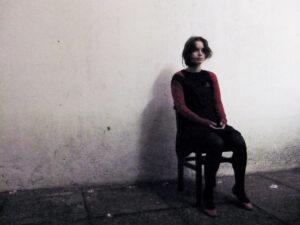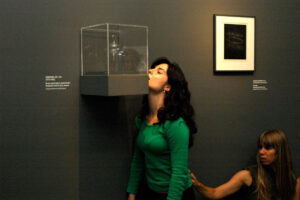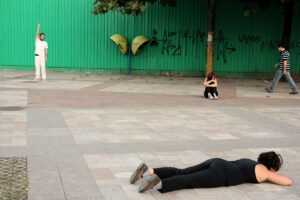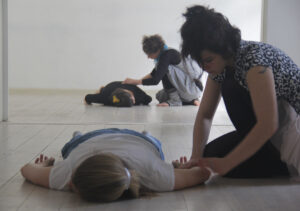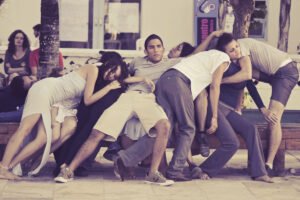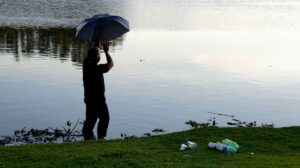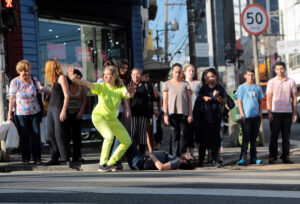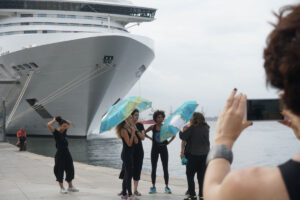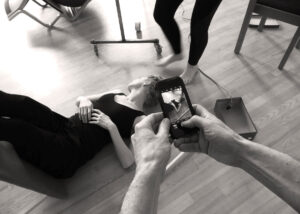Body Mapping
Body Mapping is a teaching concept that explores the relationship between the body and space, offering a reflective and experiential approach to engaging with specific places - whether in artistic, educational, or research contexts. By drawing on the principles of mapping, sensing, and documenting, it helps participants deepen their awareness of their surroundings and uncover the many layers a place holds - its history, social dynamics, and cultural meanings. At the heart of Body Mapping is the belief that every place holds stories waiting to be discovered. Through embodied observation, interaction, and documentation, these narratives can be seen, felt, and experienced. To support this process, the method combines movement-based practices, performative approaches, and tools from ethnography and spatial theory. Ultimately, Body Mapping invites participants to listen to the stories embedded in a place and to explore how these can be translated into performative expression or artistic work.
Performance Laboratory Work
A performance laboratory fosters a collaborative learning environment where participants - whether co-researchers, students, or invited guests - work together as peers in a shared process of exploration. Rooted in diverse perspectives and expertise relevant to a specific place or theme, the lab encourages cross-disciplinary dialogue with a strong focus on embodied experience. Here, the body is not only a site of personal perception and response, but also a medium for connecting with others and tuning into the environment. Central to this approach is the shift from the traditional indoor studio to public or alternative spaces. By engaging directly with real-world, socio-political contexts, participants are invited to step beyond their comfort zones and into unfamiliar territory. In doing so, each performance lab becomes a space for practicing new forms of co-existence, co-creation, and co-learning- deepening bodily awareness while cultivating sensitivity to the world around us.
Performance Documentation / Screen Performance Research
This research area explores how embodied and site-specific practices can be documented by treating the place itself as the main documentary source. It raises key questions: How can documentation support and shape the development of a performance material? How can it be embedded within site-specific inquiry? And how might the tensions between the documentary and fictional be explored through processes of archiving and editing? At the core of this investigation is the idea of the camera as a kind of co-author - an active participant in capturing, interpreting, and shaping the performance. This perspective calls for thoughtful engagement with how the camera is used on site, considering aspects such as positionality and technical choices. Equally important is the editing process, which is approached not merely as post-production, but as an embodied, compositional, and performative act. Here, gestures, rhythms, and images are choreographed to generate new narratives and perspectives. In this way, the collected materials - video, photography, sound - created in close relationship with specific places, become the foundation for a range of mediated expressions, including video essays, performed photography, and screen works.

An experience explored in different stages crystallises a social action in time and space, and transforms subjectivities into concepts which shape the formation of a "body cartography". Individually we created and recognised the detours that constitute a "collective body": place of passage and compass; movement and non-movement; entrance and exit; intimacy and overexposure; shelter and insecurity; public and private; intention and risk; " told" reverie and liminal balance.
Patrícia Naka (Workshop Centro Cultural B_arco, São Paulo, July 2011)

Can we define what we are doing here in a single word? My immediate answer would be NO! But if we thought about unleashing the words of a text? So then we would have to trespass the lines of a paper by unleashing our bodies as sort of letters in the space. And we did so, we created bonds, we connected word by word, we determined borders. For a moment there was neither body nor city! But there was simultaneity, there was a „Corporicidade“.
Caroline D‘Avila (Workshop Dramaturgy in Performance, São Paulo, August 2013)

